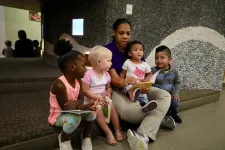(Press-News.org) Why all languages have words for ‘this’ and ‘that’
Languages around the world have words for ‘this’ and ‘that’ according to new research from an international team, led by the University of East Anglia.
Researchers studied more than 1,000 speakers of 29 different languages to see how they use demonstratives – words that show where something is in relation to a person talking such as ‘this cat’ or ‘that dog’.
It was previously thought that languages vary in the spatial distinctions they make - and that speakers of different languages may think in fundamentally different ways as a consequence.
But the new study shows that all of the languages tested make the same spatial distinctions using words like ‘this’ or ‘that’ based on whether they can reach the object they are talking about.
Lead researcher Prof Kenny Coventry, from UEA’s School of Psychology, said; “There are over 7,000 diverse languages spoken across the world.
“We wanted to find out how speakers of a wide range of languages use the oldest recorded words in all of language – spatial demonstratives, such as ‘this’ or ‘that’.”
The 45-strong international team studied 29 languages from around the world including English, Spanish, Norwegian, Japanese, Mandarin, Tzeltal and Telugu.
They tested over 1,000 speakers to see how they use demonstratives in their language to describe where objects are across a range of different spatial configurations.
Statistical analysis revealed the same mapping between reachable and non-reachable objects and demonstratives across all languages.
Prof Coventry said: “We found that in all the languages we tested, there is a word for objects that are within reach of the speaker, like ‘this’ in English, and a word for objects out of reach – ‘that’.
“This distinction may explain the early evolutionary origin of demonstratives as linguistic forms,” he added.
This research was led by the University of East Anglia in collaboration with researchers at 32 other international institutions including Friedrich-Schiller-Universität Jena, Germany, the Norwegian University of Science and Technology, Aarhus University, Denmark, and the University of Buffalo, USA.
It was funded by by EU H2020 ITN Marie Skłodowska-Curie Action grant agreement no. 676063 (DCOMM) awarded to Kenny R. Coventry and colleagues.
‘Spatial Communication Systems Across Languages Reflect Universal Action Constraints’ is published in the journal Nature Human Behaviour.
END
Why all languages have words for ‘this’ and ‘that’
2023-10-30
ELSE PRESS RELEASES FROM THIS DATE:
Low-income countries could lose 30% of nutrients like protein and omega-3 from seafood due to climate change
2023-10-30
The nutrients available from seafood could drop by 30 per cent for low-income countries by the end of the century due to climate change, suggests new UBC research.
That’s in a high carbon emissions and low mitigation scenario, according to the study published today in Nature Climate Change. This could be reduced to a roughly 10 per cent decline if the world were to meet the Paris Agreement targets of limiting global warming to 1.5 to 2 degrees Celsius - which recent reports have shown we’re not on track to achieve.
“Low-income countries and the global south, ...
Dong engineering spatial wood carbon scaffolds with nanocellulose fillers for water deionization
2023-10-30
Pei Dong, Assistant Professor, Mechanical Engineering, received $250,000 from the U.S. Department of the Interior for the project: "Engineering Spatial Wood Carbon Scaffolds with Nanocellulose Fillers for Water Deionization." This funding began in Sept. 2023 and will end in Sept. 2025.
This project seeks to create an innovative and energy-efficient capacitive deionization process with the help of biomass-based advanced porous structures for water desalination and purification.
###
About George Mason University
George Mason University is Virginia's largest public research university. Located near Washington, D.C., Mason enrolls 38,000 students from 130 countries ...
Gilleaudeau conducting geochemical analysis of carboniferous carbonates & implications for ocean oxygenation
2023-10-30
Geoffrey Gilleaudeau, Assistant Professor, Atmospheric, Oceanic and Earth Sciences (AOES), received funding for the project: "Geochemical Analysis of Carboniferous Carbonates and Implications for Ocean Oxygenation."
He and his collaborators aim to generate a new composite carbon record through the lower Mississippian in the Williston Basin. They also aim to generate a new record that tests the hypothesis that carbon excursion was related to an expansion of global ocean anoxia, ...
Russell studying Black displacement & mobility in Arlington County
2023-10-30
Russell Studying Black Displacement & Mobility In Arlington County
Donald Russell, Director, Provisions Research Center for Art & Social Change, Director, Mason Exhibitions, University Curator, College of Visual and Performing Arts (CVPA), received funding for the project: "Black Displacement and Mobility in Arlington County."
The goal of the project is to create a database of researched information that evidences Black displacement, migration, mobility, and the legacy of the Black diaspora that remains today in Arlington County.
The database will consist of maps, ...
New species of mosasaur named for Norse sea serpent
2023-10-30
Scientists have discovered a new species of mosasaur, large, carnivorous aquatic lizards that lived during the late Cretaceous. With “transitional” traits that place it between two well-known mosasaurs, the new species is named after a sea serpent in Norse mythology, Jormungandr, and the small North Dakota city Walhalla near to where the fossil was found. Details describing Jǫrmungandr walhallaensis are published today in the Bulletin of the American Museum of Natural History.
“If you put flippers on a Komodo dragon and made it really big, that’s basically what it would have looked like,” said the study’s lead ...
NSF funds holistic approach to help farmers adapt to climate change
2023-10-30
The National Science Foundation (NSF) awarded Emily Burchfield, Emory assistant professor of environmental sciences, $1.6 million to lead efforts to identify emerging pressures on agriculture in Georgia, Iowa and Ohio and to develop predictive models to help farmers and policymakers weather these changes.
“In a nutshell, we’re trying to understand what climate change will mean for agriculture in these three states,” Burchfield says. “We’ll be integrating biophysical projections based on environmental data with insights ...
University of Cincinnati study: ‘GPS’ seed devices effective in localizing breast tumors
2023-10-30
University of Cincinnati Cancer Center researchers found a seed device that acts as a GPS for surgeons to locate and remove breast and lymph node tumors was safe and effective.
The feasibility study evaluating the use of the devices, called SmartClips, was recently published in the journal The American Surgeon.
UC’s Jaime Lewis and her colleague Elizabeth Shaughnessy helped test the SmartClip devices as they were being developed.
“We went a few times and saw the different prototypes, worked with them, and provided feedback. ...
Researchers studying children’s health related to chemical exposures
2023-10-30
OKLAHOMA CITY, OKLA. – OU researchers have received a $1.8 million grant from the U.S. Environmental Protection Agency to establish a research center to address children’s cumulative health impacts from agricultural and non-chemical exposures. This grant will create the Children’s Environmental Health Center in the U.S. Southern Great Plains, which includes Oklahoma and Texas. The Center will focus on mitigating the chemical and non-chemical stressors that affect school absenteeism caused by gastrointestinal and respiratory diseases.
This collaborative center will be under the direction of Changjie Cai, Ph.D., assistant professor ...
EPA testing shows the power of D-I-Y air filters to trap viruses
2023-10-30
There is a low-cost way for you to protect yourself and reduce your risk of respiratory diseases such as flu, RSV, and COVID-19. Build yourself a Corsi-Rosenthal box (CR box) in 30 minutes with just $60 worth of common hardware store supplies.
In July, U.S. Environmental Protection Agency scientists began several weeks of advanced bioaerosol chamber testing to assess the efficacy and power of this air filter against infectious aerosols, like the virus that causes COVID-19. The results are in, and they are good.
The U.S. EPA Office of Research and Development’s 3,000 cubic ft. bioaerosol chamber testing results show ...
Year-by-year blood pressure variability from midlife to death and lifetime dementia risk
2023-10-30
About The Study: High blood pressure variability indicated increased lifetime dementia risk in late life but not in midlife in this study that included 820 adults monitored for an average time of 32 years. This result suggests that high blood pressure variability may indicate increased dementia risk in older age but might be less viable as a midlife dementia prevention target.
Authors: Jan Willem van Dalen, Ph.D., of the Radboud University Medical Center in Nijmegen, the Netherlands, is the corresponding author.
To access the embargoed study: Visit our For The Media website at this link https://media.jamanetwork.com/
(doi:10.1001/jamanetworkopen.2023.40249)
Editor’s ...



